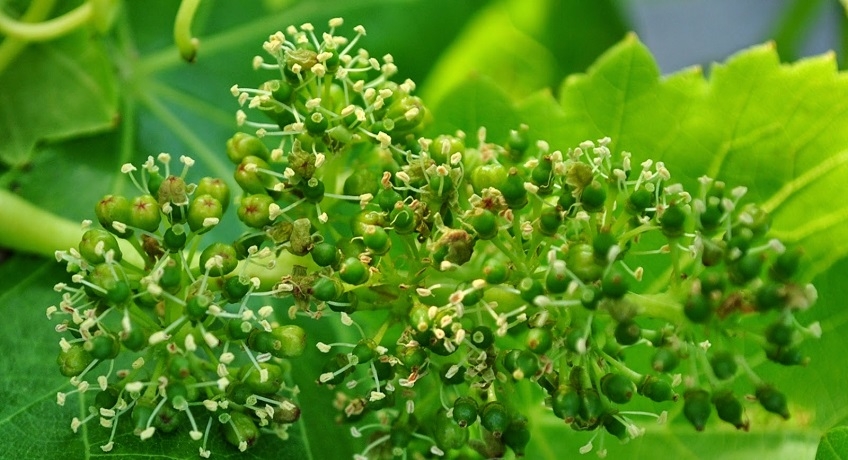
The blooming of the vine is the heart of the viticultural cycle and represents one of the most delicate and crucial phenological stages for both the quality and quantity of production. This phase, lasting between 9 and 21 days, varies depending on how gradually the phenomenon occurs on the plant and its inflorescences. Within the grape cluster, the flowers first bloom in the central parts, then in the basal parts, and finally in the apical extremities and wings.
Blooming and the Vine
The vine is a self-fertile plant, whose pollination process occurs mainly through anemophily, that is, with the help of the wind. Following pollination, fertilization takes place, during which the microspores (pollen) and the male gametophyte (pollen tube) unite with the macrospores and the female gametophyte (embryo sac), leading to double fertilization. This process is essential for the formation of the secondary endosperm, the seed’s reserve tissue.
In some seedless grape varieties, such as those with stenospermocarpy, fertilization occurs only partially, or not at all (parthenocarpy). This phenomenon is often considered a marketable advantage for certain table grapes.
How the Flower Forms
The presence and quantity of flowers are determined the previous year (year x-1) relative to the production year (year x). The induction and differentiation of flower buds occur during year x-1. The differentiation of the flowers happens at the stage of inflorescence primordia, when the dormant buds reactivate in the spring of year x. The actual blooming occurs in late spring, during the peak growth phase of the shoots. For everything to proceed correctly, specific environmental and hormonal factors predisposing the flowering must be present.
How Blooming Affects Production Yields
The complexity of the mechanisms involved in vine blooming is evident, and many factors can influence the final result. Before the final number of berries is defined, phenomena such as flower drop and fruit drop during fruit set must be considered. Other factors affecting the number of flowers per inflorescence include:
– **Carbohydrate accumulation and usage**: Insufficient carbohydrate reserves can cause flower drop, reducing the number of berries per cluster.
– **Temperature**: Temperatures below 18°C or above 38°C are unfavorable for pollen germination and pollen tube growth.
– **Rain**: Excessive rain can dilute the stigmatic fluid and interfere with pollen germination.
– **High nitrogen concentrations**: Can cause excessive flower drop.
– **Exogenous gibberellin spray**: Depending on the variety, this can have negative effects on flowering.
– **Drought**: Can promote the drop of future berries.
– **Plant shading**: Does not favor the differentiation of fertile buds nor fruit set.
Estimating Bud Fertility
The quantity of flowers determines the quantity of fruit at the end of the cycle. To ensure optimal conditions for the formation and differentiation of fertile buds, which will produce the following year, it is crucial to understand the concept of fertility. Fertility can be distinguished into:
– **Potential fertility**: The ability of a bud to differentiate into a flower, dependent on genetic and environmental factors as well as the growth rate of the shoots.
– **Real fertility**: Lower than potential fertility, it represents the buds that actually flower in spring.
A Fertile Future at Fattoria di Montemaggio
The real fertility of the vineyard indicates how many of the buds left on the plant become inflorescences. Knowing the real fertility in autumn, before winter pruning, allows for more rational and suitable pruning for each vineyard. Studies such as those conducted by Giuseppe Ferrara and Andrea Mazzeo at the University of Bari have shown the importance of estimating real fertility to optimize pruning and improve productivity.
At Fattoria di Montemaggio, we are committed to using this knowledge and innovative techniques to ensure that every blooming season is a success, producing grapes of the highest quality. Through the use of scientific methods and careful agronomic management, we continue to enhance the real fertility of our vineyards, ensuring a fertile and productive future for our vines.






Leave a Reply